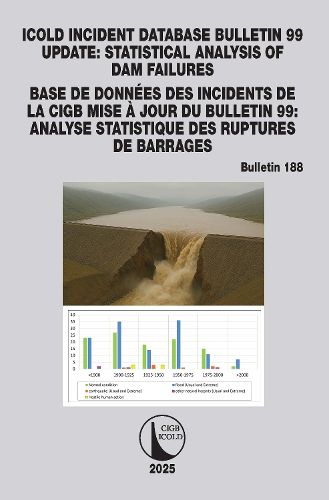Readings Newsletter
Become a Readings Member to make your shopping experience even easier.
Sign in or sign up for free!
You’re not far away from qualifying for FREE standard shipping within Australia
You’ve qualified for FREE standard shipping within Australia
The cart is loading…






In all hazardous industries, incident analysis is an important tool to improve safety. Understanding the causes of incidents makes it possible to change what was identified as a weakness, either in the design, the construction or the operation of any industrial plant. Dams obey the same rules, and it is the reason why ICOLD has always been involved in dam incidents collection and analysis.
Since 2005 the Committee on Dam Safety has been collecting additional information on dam incidents and considered that it was time to update this last publication (Bulletin 99) which listed the cases of failures up to 1991. It was therefore up to ICOLD, and to its Committee on Dam Safety, to carry out this survey and analysis with the objective of meeting the needs of the dam professionals.
For this update other important attributes have been added, such as the context of failures (normal operation, flood, earthquakes, etc.), the failure mode, and the failure causes. Current concepts allow us to better define these notions and have been used to qualify these parameters.
Dans toutes les industries a risques, l'analyse des incidents est un outil important pour ameliorer la securite. Comprendre les causes des incidents permet de modifier ce qui a ete identifie comme une faiblesse, que ce soit dans la conception, la construction ou l'exploitation de toute installation industrielle. Les barrages obeissent aux memes regles, et c'est la raison pour laquelle la CIGB a toujours ete active pour la collecte et l'analyse des incidents de barrage.
Depuis 2005, le Comite pour la securite des barrages a collecte des informations supplementaires sur les incidents de barrages et a estime qu'il etait temps de mettre a jour cette derniere publication qui repertoriait les cas de ruptures jusqu'en 1991. Il revenait donc a la CIGB, et a son Comite sur la securite des barrages, de realiser cette enquete et cette analyse dans le but de repondre aux besoins des professionnels des barrages.
Pour cette mise a jour, d'autres attributs importants ont ete ajoutes, tels que le contexte des ruptures (fonctionnement normal, inondation, seismes, etc.), le mode de defaillance et les causes de la rupture. Les concepts actuels permettent de mieux definir ces notions et ont ete utilisees pour qualifier ces parametres.
$9.00 standard shipping within Australia
FREE standard shipping within Australia for orders over $100.00
Express & International shipping calculated at checkout
In all hazardous industries, incident analysis is an important tool to improve safety. Understanding the causes of incidents makes it possible to change what was identified as a weakness, either in the design, the construction or the operation of any industrial plant. Dams obey the same rules, and it is the reason why ICOLD has always been involved in dam incidents collection and analysis.
Since 2005 the Committee on Dam Safety has been collecting additional information on dam incidents and considered that it was time to update this last publication (Bulletin 99) which listed the cases of failures up to 1991. It was therefore up to ICOLD, and to its Committee on Dam Safety, to carry out this survey and analysis with the objective of meeting the needs of the dam professionals.
For this update other important attributes have been added, such as the context of failures (normal operation, flood, earthquakes, etc.), the failure mode, and the failure causes. Current concepts allow us to better define these notions and have been used to qualify these parameters.
Dans toutes les industries a risques, l'analyse des incidents est un outil important pour ameliorer la securite. Comprendre les causes des incidents permet de modifier ce qui a ete identifie comme une faiblesse, que ce soit dans la conception, la construction ou l'exploitation de toute installation industrielle. Les barrages obeissent aux memes regles, et c'est la raison pour laquelle la CIGB a toujours ete active pour la collecte et l'analyse des incidents de barrage.
Depuis 2005, le Comite pour la securite des barrages a collecte des informations supplementaires sur les incidents de barrages et a estime qu'il etait temps de mettre a jour cette derniere publication qui repertoriait les cas de ruptures jusqu'en 1991. Il revenait donc a la CIGB, et a son Comite sur la securite des barrages, de realiser cette enquete et cette analyse dans le but de repondre aux besoins des professionnels des barrages.
Pour cette mise a jour, d'autres attributs importants ont ete ajoutes, tels que le contexte des ruptures (fonctionnement normal, inondation, seismes, etc.), le mode de defaillance et les causes de la rupture. Les concepts actuels permettent de mieux definir ces notions et ont ete utilisees pour qualifier ces parametres.